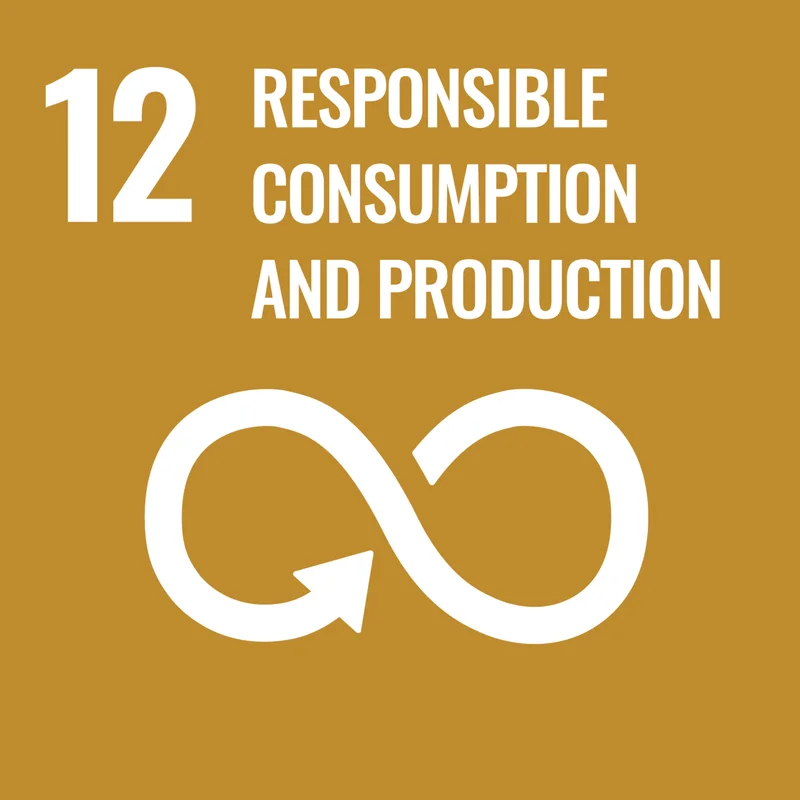SDG 12
Responsible production and consumption
The twelfth Sustainable Development Objective of the United Nations aims to establish sustainable modes of consumption and production. However, the way the tobacco industry functions is in flagrant contradiction to these objectives. Cigarettes are the only consumer product which kills at least half of its users, especially when the makers’ instructions are followed to the letter.
Globally, tobacco kills at least 8.2 million people each year, of which 1.2 million die from second-hand smoke.[1] In Switzerland, 9500 people die every year as a result of smoking, or one person every hour.[2] To that can be added the effects on the environment caused by tobacco consumption, particularly the billions of cigarette butts thrown on the ground every year, as well as the harmful effects of greenhouse gases.

Nor does the manufacturing of cigarettes fulfill the criteria for responsible production. Tobacco cultivation contributes to deforestation, soil erosion, and the contamination of streams and rivers, while monopolising land which could be used for growing food and other essential crops. It also helps keep tobacco farmers in a cycle of poverty. In the fields as well as in the factories, cigarette companies use child labor and frequently treat their workers like slaves.
The establishment of responsible production and consumption requires that these jobs be transformed into productive employment which can generate real value for humanity, and which ensure decent working conditions for those who do them. Some countries have already adopted substitution programs, like Kenya which has instituted a training program for its farmers to encourage them to give up tobacco farming for beans. Those who have taken this step have seen their incomes increase noticeably.[3]
Malawi has started a program of subsidies and seed distribution to encourage the production of cotton, tea, sugar, and legumes in place of tobacco. But this change is not without its obstacles: lack of arable land, the need to wait several years before some crops – such as fruit trees – become profitable, and competition from richer countries have hampered these efforts.[4]
Nor do the large subsidies enjoyed by the tobacco industry favour these changes. The 26,000 European farmers who grow this nicotinic plant will receive around 100 million euros in the upcoming EU agricultural plan from 2023 to 2027.[5] In Switzerland, the SOTA fund, which aims to promote tobacco growing locally, receives 13 million francs annually,[6] whereas the number of Swiss tobacco growers has continually declined and there were only 135 of them left in 2020.[7]
This fact has not stopped the tobacco industry from adopting the language of responsible production and consumption. As early as the beginning of the 21st century, it began to invest large sums of money in reports on social responsibility, often lengthy and richly illustrated. British American Tobacco published its report for the first time in 2003, and in 2020 it launched a program of “environmental and social oversight,” which promised, in particular, to reduce the health and environmental impact of its products.[8]
For its part, Philip Morris International has created a dedicated on-line platform, with numerous case studies detailing its activities regarding environmental protection or the defense of human rights.[9] The Altria group has multiplied its donations to these causes. In 2018 alone, it gave 5.6 million dollars to environmental NGOs. It also finances museums, gay pride activities, and the American Red Cross.[10] In Switzerland as well, PMI finances many NGOs, and the Swiss Red Cross in particular has been accepting their donations for a long time.
These actions of social responsibility allow cigarette makers to represent themselves as a part of the solution rather than part of the problem, to have access to the settings where decisions are made about controlling tobacco use, and even to promote themselves in places where advertising for cigarettes is forbidden. Anti-smoking organisations have regularly complained about these offenses.[11]
Behind the scenes, the tobacco companies have behaved much less responsibly. Aware that their future depends on recruiting new smokers, they continue to advertise their products to young people. This is generally done indirectly, disguised as anti-smoking efforts. The Philip Morris campaign entitled “Think, Don’t Smoke” was thus founded on two messages – smoking is an adult act, and it carries a risk – more likely to attract adolescents than to turn them away from smoking.[12]
Developing countries represent the other future market targeted by cigarette manufacturers, especially since it has become difficult for them to advertise in developed countries. Africa in particular has been targeted. In Nigeria, it is not rare to see a school play area surrounded by signs advertising Marlboros or Lucky Strikes. Similarly, cigarettes are sold there individually - a practice which has been banned in many countries – which makes them accessible to children and to very low-income people.[13]
The effects of these campaigns have already been begun to be felt. Africa is the continent with the fastest-growing number of smokers over the past 30 years. In North Africa and the Middle East, this growth reached 104% during this period. In sub-Saharan Africa, it has been 75%.[14] This is a worrisome trend which will undoubtedly not appear in the reports on social responsibility put out by the big tobacco companies.
[1] https://www.who.int/news-room/fact-sheets/detail/tobacco
[2] https://faits-chiffres.addictionsuisse.ch/fr/tabac/effets-risques/risques-consequences.html
[3] https://news.un.org/en/story/2022/03/1114502
[4] Lencucha R, Moyo T, Labonte R, Drope J, Appau A, Makoka D. Shifting from tobacco growing to alternatives in Malawi? A qualitative analysis of policy and perspectives. Health Policy Plan. 2020;35(7):810-818. doi:10.1093/heapol/czaa057
[5] https://ihsmarkit.com/research-analysis/eu-keeps-pumping-100-million-into-tobacco-production.html
[7] https://www.at-schweiz.ch/fr?id=109&La-production-de-tabac-en-Suisse
[8] https://tobaccotactics.org/wiki/csr-strategy/
[10] https://tobaccotactics.org/wiki/csr-strategy/
[12] Ibidem
[14] GBD 2019 Tobacco Collaborators. Spatial, temporal, and demographic patterns in prevalence of smoking tobacco use and attributable disease burden in 204 countries and territories, 1990-2019: a systematic analysis from the Global Burden of Disease Study 2019 [published correction appears in Lancet. 2021 Jun 19;397(10292):2336]. Lancet. 2021;397(10292):2337-2360. doi:10.1016/S0140-6736(21)01169-7